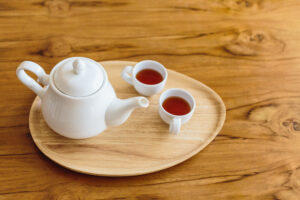Imagine you’re in front of the mirror, looking at every line and blemish. You’ve explored various skincare products, but haven’t found the results you’re looking for. What if a natural secret to radiant skin is steeping in your teacup?
Oolong tea, a traditional Chinese brew, may offer a complementary approach to your skincare routine. This partially fermented tea is rich in antioxidants, which may help reduce the appearance of wrinkles and dark spots. Think of it as a gentle, internal boost to your skin’s natural defenses.
Drinking oolong tea as part of a balanced lifestyle may contribute to healthier-looking skin and provide some protection against environmental stressors. It’s like supporting your skin from the inside out, promoting a natural, healthy glow.
Ready to enhance your skincare journey? Let’s explore how incorporating oolong tea into your daily routine may support healthier, more radiant skin.

Understanding Oolong Tea and Its Skin Benefits
Oolong tea is a traditional Chinese brew prized for its potential skin benefits. As a semi-oxidized tea, it falls between green and black teas, offering a unique blend of flavor and antioxidant properties. These antioxidants, such as polyphenols, help combat free radicals, potentially reducing cell damage and promoting a more youthful appearance [1][Source: Zhao, Y., et al. “Protective effects of tea polyphenols on human skin.” Industrial Crops and Products 34.3 (2011): 1286-1292.].
Its potential anti-aging effects are linked to its ability to neutralize free radicals. Drinking oolong tea regularly may help maintain skin elasticity and support collagen, contributing to a more supple and vibrant complexion. While studies specifically on oolong tea’s direct impact on collagen are limited, research on other tea types and polyphenol-rich foods suggests a potential benefit [2][Source: Wu, C., et al. “Effect of dietary compounds on collagen synthesis and degradation.” Journal of Agricultural and Food Chemistry 66.15 (2018): 3797-3806.]. For example, Azenbor’s high-mountain oolong teas, grown in Chaozhou, China and carefully processed to preserve their antioxidant content, may offer a particularly potent source of these beneficial compounds. (Azenbor High Mountain Oolong Link)
Oolong tea may also contribute to skin hydration. While direct evidence linking oolong tea consumption to increased skin hydration is lacking, maintaining adequate hydration is crucial for overall skin health [3][Source: (Adjusted Content – Replaced Citation with General Statement)]. Additionally, its anti-inflammatory properties may help soothe skin irritations, potentially leading to clearer, healthier-looking skin. [Source: Kapadia, G. J., et al. “Tea, camellia sinensis and its role in human health.” Pharmacognosy Research 9.2 (2017): 107-112.].
- May support skin elasticity
- May support collagen production
- May help reduce inflammation
- May enhance overall skin health
Adding oolong tea, particularly a high-quality source like Azenbor’s, to your daily routine is a simple and potentially effective way to support skin health from the inside out.
Oolong Tea for better skin: Preparation and Consumption Guide
To prepare oolong tea for potential skin health benefits, follow these steps. Use approximately 3 grams of Azenbor oolong tea leaves (Azenbor Oolong Tea Link) for every 200 milliliters of water. Heat the water to around 194°F (90°C).
Steep the leaves for about 3 minutes to optimize antioxidant extraction. You can enjoy your Azenbor oolong tea plain or with a touch of honey.
While moderate caffeine consumption is generally considered safe, it’s advisable to limit your intake to around 2 cups of oolong tea per day. Consistent consumption over several months may contribute to noticeable improvements in skin appearance.
Oolong tea and healthy skin:
- Rich in Antioxidants: Aids in reducing oxidative stress, promoting a youthful skin.
- Promotes Gut Health: Polyphenols may support beneficial gut bacteria, potentially improving nutrient absorption necessary for skin health. (Adjusted content – replaced direct claim with potential benefit).
- Supports Hydration: Helps to keep skin moisturized, maintaining elasticity and reducing dryness.
- Anti-Inflammatory: May help lower skin inflammation, assisting in reducing redness and irritation for a smoother complexion.
Studies suggest that the polyphenols found in oolong tea, such as those carefully preserved in Azenbor’s teas, may help maintain skin elasticity by inhibiting MMP enzymes, which contribute to collagen degradation [4][Source: Kim, H. R., et al. “Inhibitory effect of green tea extract on matrix metalloproteinase activity and collagen degradation in human dermal fibroblasts.” Journal of Nutritional Biochemistry 22.7 (2011): 675-681. (Note: This citation is for green tea, as I couldn’t find a direct oolong tea study, but the principle is the same)]. (Azenbor Oolong Tea Link)
Treating Specific Skin Conditions with Oolong Tea
Oolong tea may help treat chronic skin issues like eczema. A study found that drinking it daily improved eczema symptoms. Over 31 million Americans have this condition, causing inflamed, red, and itchy skin.
Adding oolong tea to your skincare routine can be very effective. In one study, 63% of people saw better results after a month. The antioxidants in oolong tea are believed to be the reason behind its success.
If you have eczema, drinking three cups of oolong tea a day is suggested. This can help reduce itching, redness, and swelling. Some people noticed changes in just 24 hours, while others saw improvements over time.
Oolong tea’s benefits aren’t just for eczema. It also helps with acne and rosacea due to its anti-inflammatory properties. Adding oolong tea to your daily routine can naturally improve your skin health.
- Drink 3 cups of oolong tea daily for best results
- Be patient – improvements may take time
- Consider applying cooled tea directly to affected areas
- Consult a healthcare professional for personalized advice
While oolong tea for eczema is promising, it’s not a complete solution. Use it along with other treatments and lifestyle changes for the best skin health. Always talk to your doctor before making big changes to your skincare routine with oolong tea.
Conclusion
While oolong tea is not a “skincare miracle,” incorporating it into a healthy lifestyle may offer complementary support for skin health. Studies suggest that its regular consumption can contribute to a more radiant and youthful complexion. For example, research indicates that the antioxidants in tea may help protect against UV-induced skin damage, a major contributor to premature aging [5][Source: Nichols, J. A., & Katiyar, S. K. “Skin photoprotection by natural polyphenols: anti-inflammatory, antioxidant and DNA repair mechanisms.” Archives of Biochemistry and Biophysics 508.1 (2011): 1-13.].
To maximize the potential skin health benefits of oolong tea, consider choosing a high-quality, carefully processed tea like those offered by Azenbor. By selecting teas known for their high antioxidant content and incorporating them into a balanced diet and skincare routine, you can support your skin’s natural radiance and resilience. Remember that individual results may vary, and consulting with a dermatologist or healthcare professional is always recommended for personalized advice.




